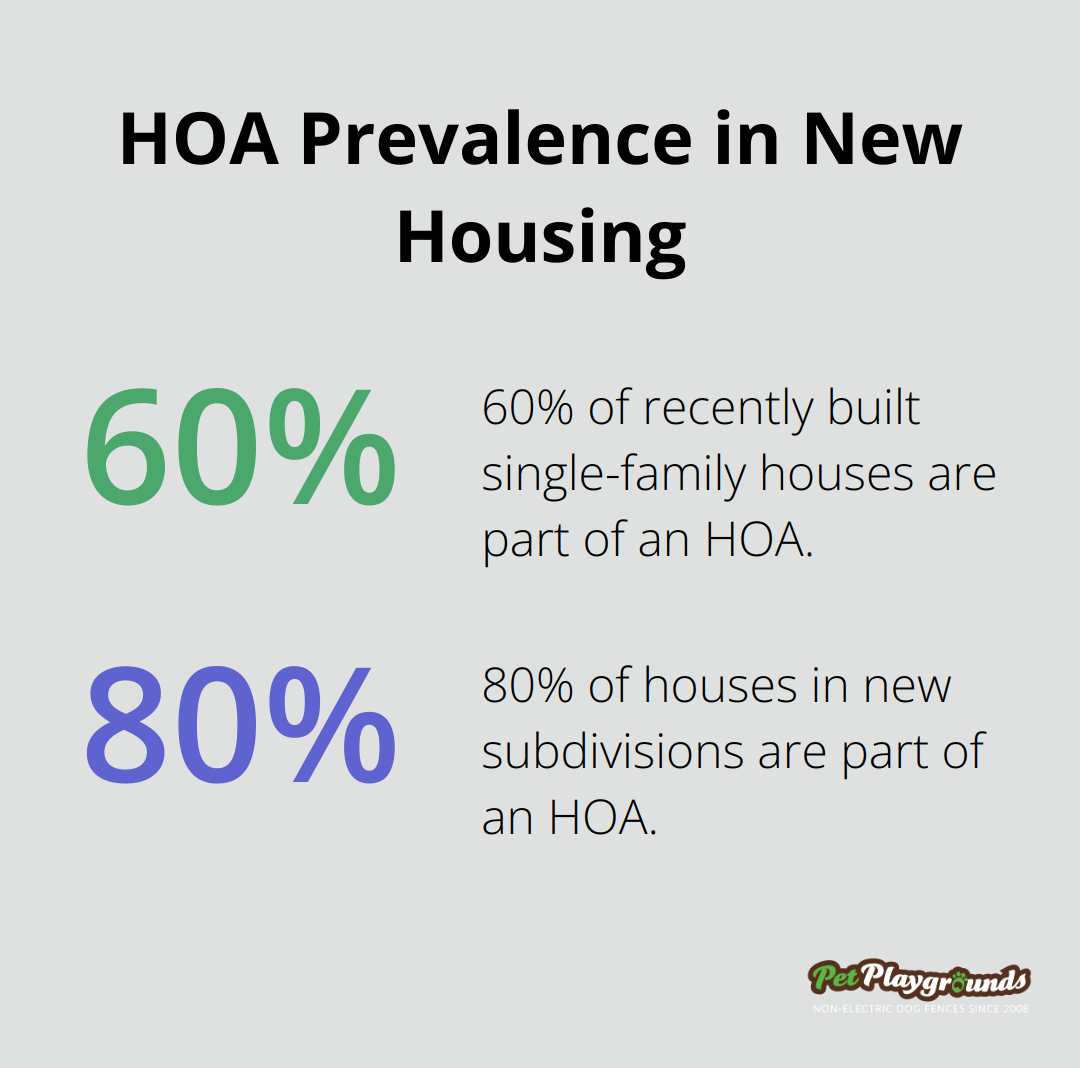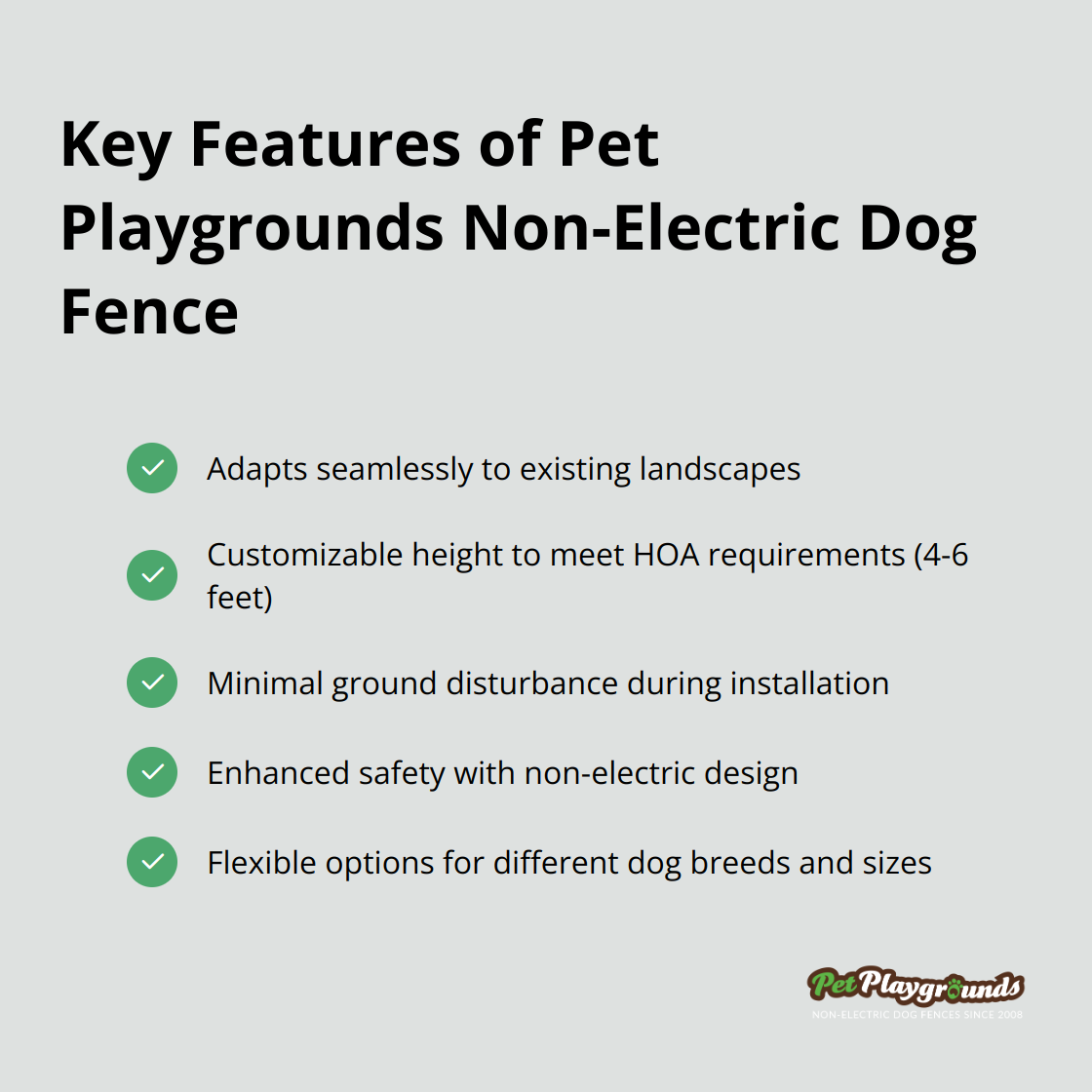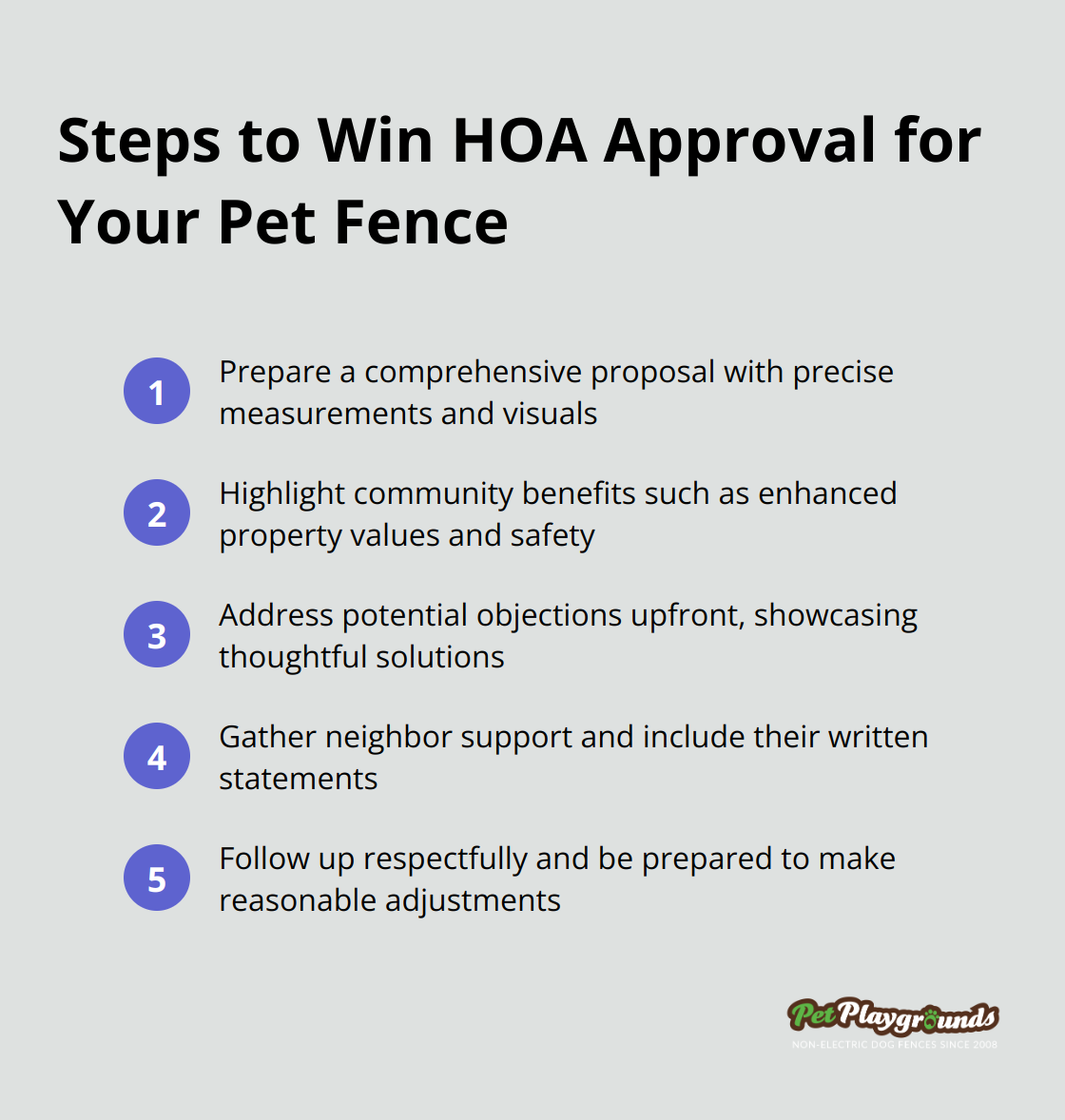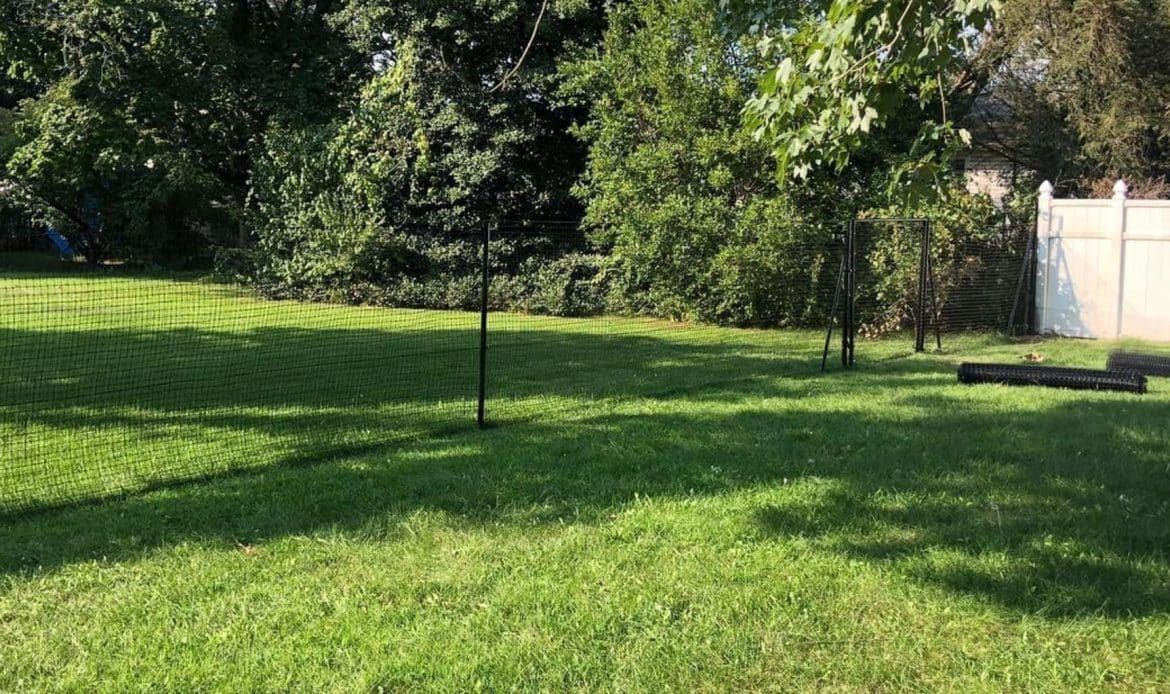Living in a neighborhood with a Homeowners Association (HOA) can present unique challenges when it comes to pet fencing. Many homeowners find themselves caught between their desire to keep their furry friends safe and the need to comply with neighborhood regulations.
At Pet Playgrounds Non Electric Dog Fence, we understand the importance of balancing pet safety with HOA requirements. This guide will help you navigate the often complex world of HOA rules for pet fencing, ensuring you can create a secure space for your pet while maintaining harmony with your community.
HOA Fencing Rules: What You Need to Know
Common Fence Restrictions
Homeowners Associations (HOAs) often impose specific guidelines for pet fencing. These rules typically aim to maintain a uniform neighborhood appearance, which can affect the type, height, and placement of allowed fences.
Most HOAs limit fence heights to between 4 and 6 feet. They may also specify acceptable materials, colors, and styles. For example, some associations prohibit chain-link fences or require wooden fences to be stained a particular color. Nearly 60% of recently built single-family houses, and 80% of houses in new subdivisions, are part of a homeowners association (HOA), highlighting the widespread impact of these regulations.

Reviewing Your HOA’s CC&Rs
Before you plan any fencing project, you must thoroughly review your HOA’s Covenants, Conditions, and Restrictions (CC&Rs). This document outlines all rules and regulations for your community, including those related to fencing. The Community Associations Institute notes that trustees are currently required in certain states and in certain CC&Rs, and can be charged with and expected to enforce these regulations.
Navigating the Approval Process
Most HOAs require homeowners to submit a detailed plan for approval before installing a fence. This process typically involves:
- Submitting a written request with fence specifications
- Providing a property survey showing the proposed fence location
- Including color samples or material descriptions
- Waiting for board review (which can take 30-60 days)
Some HOAs may require the use of pre-approved contractors or specific brands of fencing materials. You should factor these requirements into your planning and budget.
Alternative Solutions for Strict HOAs
For homeowners who face strict HOA regulations, non-intrusive fencing solutions offer an excellent alternative. These systems often comply with even the most stringent rules due to their ability to blend with existing landscapes. Pet Playgrounds Non-Electric Dog Fence, for instance, provides a solution that adapts well to various HOA requirements while ensuring pet safety.
Communication is Key
Open communication with your HOA board can greatly smooth the approval process. Many boards are willing to work with homeowners to find mutually acceptable solutions that keep pets safe while maintaining neighborhood standards. You should approach your board with a clear plan and a willingness to compromise if necessary.
As you consider your fencing options, it’s important to understand how different solutions can meet both your needs and HOA requirements. Let’s explore one particular option that has proven effective in many HOA communities.
A Non-Intrusive Fencing Solution for HOA Communities
Adapting to Existing Landscapes
Pet Playgrounds Non-Electric Dog Fence stands out as a premium option that combines safety, aesthetics, and durability. This system addresses many common HOA concerns while providing a secure environment for pets. The poly mesh material (available in colors that complement natural surroundings) integrates seamlessly with existing gardens, trees, and terrain. This feature makes it less obtrusive and more likely to meet HOA aesthetic standards.
Meeting Height Requirements
Many HOAs enforce strict rules about fence height (typically limiting them to 4-6 feet). Pet Playgrounds’ system allows customization to meet these requirements. A standard height of 4 feet often suffices for most dogs, while still complying with common HOA regulations. For homeowners with larger breeds or more stringent containment needs, the system adjusts up to 6 feet without compromising its effectiveness or aesthetic appeal.
Minimizing Ground Disturbance
HOAs often worry about extensive landscaping changes or permanent structures. Pet Playgrounds’ system addresses these issues with its straightforward installation process. The fence sets up without the need for concrete or extensive digging, which minimizes disruption to the existing landscape. This feature increases the likelihood of gaining HOA approval and allows for easier removal or modification if needed in the future.
Enhancing Safety Features
The non-electric nature of this fencing solution eliminates concerns about underground wiring or potential hazards associated with electric fences. This can serve as a significant selling point when presenting the system to an HOA board, as it demonstrates a commitment to both pet and community safety.

Offering Flexibility for Various Needs
Pet Playgrounds’ system provides options for different dog breeds and sizes, ensuring that homeowners can find a solution that works for their specific pet while still adhering to HOA guidelines. This flexibility, combined with the system’s durability and long-lasting materials, makes it a worthwhile investment for creating a private dog park that enhances a dog’s life, health, and even trainability.
As we move forward, let’s explore how to effectively present your fencing plan to your HOA board and address potential concerns proactively.
How to Win HOA Approval for Your Pet Fence
Prepare a Comprehensive Proposal
You should create a detailed proposal that addresses all potential HOA concerns. Include precise measurements, materials, colors, and placement of your fence. Use professional-quality diagrams or 3D renderings to help board members visualize the end result. As an alternative to the installation of a visible fence, homeowners may choose an electronic dog fence to contain dogs.

Highlight Community Benefits
You must frame your fence as a benefit to the entire neighborhood. Emphasize how it will enhance property values by maintaining a tidy appearance and preventing loose pets. Also, point out how your fence will contribute to community safety by keeping pets secure and reducing the risk of animal-related incidents.
Address Potential Objections Upfront
You need to anticipate and address common HOA concerns before they arise. If visibility is an issue, showcase how mesh designs maintain open sightlines. For durability concerns, highlight strong materials and weather resistance. Your proactive approach will demonstrate thoughtfulness and commitment to community standards.
Gather Neighbor Support
Before the HOA meeting, you should discuss your plans with immediate neighbors. Their support can significantly influence the board’s decision. Living in a development governed by a homeowners association has several important benefits. Collect written statements of support if possible, and include these in your proposal.
Follow Up and Be Flexible
After you submit your proposal, follow up regularly but respectfully with the HOA board. You must prepare to make reasonable adjustments if requested. HOA boards appreciate homeowners who show willingness to compromise.
Clear communication and thorough documentation are essential throughout this process. Keep records of all interactions, agreements, and changes to your proposal. This paper trail will prove invaluable if any questions or disputes arise later.
Final Thoughts
Navigating HOA rules for pet fencing requires a strategic approach and innovative solutions. Pet Playgrounds Non-Electric Dog Fence offers homeowners a way to balance pet safety with neighborhood regulations. This system adapts to existing landscapes, meets height requirements, and minimizes ground disturbance, making it an attractive choice for various dog breeds and sizes.
The benefits of Pet Playgrounds extend beyond compliance, creating a secure environment that enhances your pet’s life and health. With its four levels of security (including a dig guard and anti-climb design), it provides robust protection against wildlife. The system’s durability and long-lasting materials make it a worthwhile investment for creating a private dog park.
Don’t let neighborhood regulations prevent you from providing a safe outdoor space for your pet. Take action today to ensure your pet’s safety and enjoy peace of mind in your HOA community. Pet Playgrounds Non-Electric Dog Fence can help you create a harmonious balance between your pet’s needs and your HOA’s requirements.























